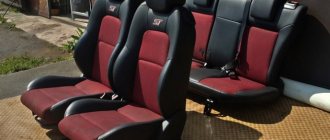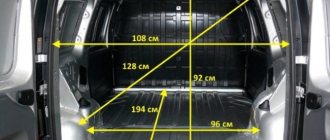Lada Priora became the successor of the VAZ-2110, adopting several elements from it and gaining the sympathy of domestic car owners - where would we be without cans. About 400 parts were redone. In its segment, Lada Priora receives one of the best ratings due to its unpretentiousness and good performance. But what exactly is worth saying about the car is that the technical characteristics of the Priora car are quite decent for its class.
AvtoVAZ introduced the VAZ-2170 model in the mid-2000s, Priora was produced from 2007 to 2022, and in 2013 it underwent restyling with minor changes. Over the years, a large number of VAZ cars have been produced, and many ideas have emerged to improve and stylize Lada Priora cars. Technical characteristics are the point at which an experienced driver chooses a car; you shouldn’t buy it for its pretty eyes. Although look at the picture below and her eyes. 
Main characteristics
| Brand | VAZ |
| Model | Lada Priora Hatchback |
| Modification | Lada Priora Hatchback 1.6 MT 98 hp |
| Model year | 2013 |
| Body type | Hatchback |
| Number of doors | 5 |
| Number of seats | 5 |
| Country of assembly | Russia |
Performance characteristics
| Type of fuel | AI-95 |
| Acceleration time to 100 km/h | 11.5 sec |
| Maximum speed | 183 km/h |
| Fuel consumption in the urban cycle | 9.1 l per 100 km |
| Fuel consumption on the highway | 5.5 l per 100 km |
| Combined fuel consumption | 6.9 l per 100 km |
| Power reserve | 473 – 782 km |
| Fuel costs per year (with a mileage of 100 km per day) | 119 629₽ |
| Transport tax * (Moscow) | 1 176₽ |
| OSAGO * (Moscow, age over 22 years, experience over 3 years) | 7 570₽ |
* Use Tax and OSAGO calculators for more detailed calculations.
Dimensions and dimensions
| Length | 4210 mm |
| Width | 1680 mm |
| Height | 1435 mm |
| Ground clearance | 165 mm |
| Front track | 1410 mm |
| Rear track | 1380 mm |
| Wheelbase | 2492 mm |
| Turning diameter | 11.6 m |
Weight
| Curb weight | 1163 kg |
| Full mass | 1578 kg |
| Load capacity | 415 kg |
Volumes
| Trunk volume | 360 l |
| Fuel tank volume | 43 l |
Engine
| engine's type | Petrol |
| Number of cylinders / arrangement | 4/Inline |
| Engine power, hp/rpm | 98/5600 |
| Engine displacement | 1596 cm³ |
| Torque, Nm/rpm | 145/4000 |
Transmission
| Drive unit | Front |
| Gearbox type | Mechanical, 5 gears |
Body
Catalog number and cost of the standard Priora fuel tank
The official article number for the Priora fuel tank is: 21082110101370. Its cost is 3.5-5.5 thousand Russian. rub. In addition, now you can easily purchase a used gas tank for our car in excellent condition. The price for such a tank varies between 1-2 thousand Russian. rub. You can also take into account that the Priora’s tank is exactly the same as that of the “eight” and “ten”, with the same volume. If you need to find out about the traffic police, fines, traffic rules and car insurance, visit https://progai.info/.
Modifications of Lada Priora
Lada Priora 1.6 AMT
| Maximum speed, km/h | 183 |
| Acceleration time to 100 km/h, sec | 11.4 |
| Engine | Petrol |
| Working volume, cm3 | 1596 |
| Power, hp / rpm | 106/5800 |
| Torque, Nm/rpm | 148/4200 |
| Combi consumption, l per 100 km | 6.6 |
| Gearbox type | Robotic, 5 gears |
| Drive unit | Front |
Lada Priora 1.6 MT
| Maximum speed, km/h | 176 |
| Acceleration time to 100 km/h, sec | 12.5 |
| Engine | Petrol |
| Working volume, cm3 | 1596 |
| Power, hp / rpm | 87/5100 |
| Torque, Nm/rpm | 140/3800 |
| Combi consumption, l per 100 km | 7.0 |
| Gearbox type | Mechanical, 5 gears |
| Drive unit | Front |
Lada Priora 1.6 MT 106 hp
| Maximum speed, km/h | 183 |
| Acceleration time to 100 km/h, sec | 11.5 |
| Engine | Petrol |
| Working volume, cm3 | 1596 |
| Power, hp / rpm | 106/5800 |
| Torque, Nm/rpm | 148/4200 |
| Combi consumption, l per 100 km | 6.9 |
| Gearbox type | Mechanical, 5 gears |
| Drive unit | Front |
Lada Priora 1.6 MT 98 hp
| Maximum speed, km/h | 183 |
| Acceleration time to 100 km/h, sec | 11.5 |
| Engine | Petrol |
| Working volume, cm3 | 1596 |
| Power, hp / rpm | 98/5600 |
| Torque, Nm/rpm | 145/4000 |
| Combi consumption, l per 100 km | 6.9 |
| Gearbox type | Mechanical, 5 gears |
| Drive unit | Front |
Performance characteristics of the Priora car engine: 126 and 127, how many horsepower and torque
The technical characteristics of the Priora car engine show 98 and 106 horsepower on board. This applies to engines with a displacement of 1.6 liters.
- Motor - 98 horsepower received number 21126. Maximum torque - 4000 rpm at 145 Nm.
- Motor - 106 horsepower is listed under number 21127, torque - 4,200 rpm at 148 km.
Motor 21127 is a modified version of the 126 model, but both of them are available with sixteen valves. In addition, the Priora has two eight-valve engines with a displacement of 1.6 liters, which produce 81 and 87 hp, but they are not as common as newer versions. Interestingly, there are engines with a volume of 1.8 liters.
- The first 1.8 liter engine produces 98 hp. (21127 also works), but the torque is 3000 rpm at 160 Nm.
- The 123 hp engine, which was installed on sports versions, produces 4000 rpm at 165 Nm.
Compared to the weight of the car, sixteen-valve engines are sufficient for free movement.
As for the technical condition, the VAZ-21126 and subsequent models are superior to eight-valve versions of engines, which is why car owners choose them more often. The most common “layout” is the Priora sedan with a 21126 engine and a manual transmission.
Technical characteristics of Lada Priora station wagon
The dimensions of the Priora station wagon, after restyling, have changed slightly due to new bumpers. So previously the length of the car was 4,330 mm, now it is 4,340 mm. It is also worth noting that the ground clearance of the Lada Priora station wagon is 5 mm greater than that of the sedan and hatchback and is equal to 170 mm. This difference is explained by the reinforced suspension, since the station wagon is designed not only for transporting passengers, but also for transporting all kinds of cargo. In particular, the car's rear springs have more coils. The height of the car is also greater when compared with its siblings. There is no big secret here, it’s just that all Lada Priora station wagons come standard with roof rails. See the detailed overall dimensions of the Priora station wagon below.
Dimensions, ground clearance, trunk Lada Priora station wagon
- Length – 4340 mm
- Width – 1680 mm
- Height – 1508 mm
- Curb weight/gross weight – 1185 / 1593 kg
- Front/rear wheel track – 1410 / 1380 mm
- Base, distance between front and rear axle – 2492 mm
- Trunk volume – 444 liters
- Trunk volume with seats folded – 777 liters
- Fuel tank volume – 43 liters
- Tire size – 175/65 R14 or 185/60 R14 or 185/65 R14
- Ground clearance of the Lada Priora station wagon – 170 mm
As for the power units, here, as in the case of the hatchback and sedan, there are two engines to choose from, this is the VAZ-21126 engine with a power of 98 hp. and a more advanced modification with passive supercharging VAZ-21127 with a power of 106 hp. However, unofficially the VAZ-21127 engine produces a little more horses. Both engines have 4 cylinders and 16 valves, two camshafts driven by a belt. Below are the parameters of these motors.
Characteristics of the VAZ-21126 16 class engine. Manual transmission 5-speed
- Working volume – 1596 cm3
- Power hp/kW – 98/72 at 5600 rpm
- Torque – 145 Nm at 4000 rpm
- Fuel consumption in the combined cycle – 6.9 liters
Characteristics of the VAZ-21127 16 cl. Manual transmission 5-speed
- Working volume – 1596 cm3
- Number of cylinders/valves – 4/16
- Power hp/kW – 106/78 at 5800 rpm
- Torque – 148 Nm at 4200 rpm
- Maximum speed – 183 kilometers per hour
- Acceleration to the first hundred – 11.5 seconds
- Fuel consumption in the combined cycle – 6.8 liters
Rules for long-term use
Surely every Priora owner wants to operate his car without unnecessary unexpected costs and is thinking about how to increase the car’s service life. To do this you need to follow a few simple rules:
- The power unit of the VAZ 2170, even without various improvements, has sufficient potential for “spirited” driving. But in order to save it and extend its life, such driving should be avoided. Smooth acceleration and maintaining a stable speed not only on the highway, but also in the city will help extend the life of the engine and save fuel and your own money. The maximum permissible speed on the highway should be no higher than 120 km/h, the optimal speed is 100-110 km/h, and it is important to maintain stability.
- It is important to timely replace consumables, that is, oils in units, filters, spark plugs, high voltage wires, generator and timing belts, and coolant. The interval between engine oil changes depends on its quality and chemical base. Mineral-based oils should be changed more often, synthetic oils less often. You should never determine the quality of motor oil by its color. If it has acquired a black tint, this does not mean that the oil is bad - it means that an excessive amount of combustion product deposits is formed in the engine. First of all, you need to find the source of the carbon deposits and eliminate it, and then change the oil.
- The new engine must be properly broken in, and then the oil must be changed, following the manufacturer's instructions. When running in, avoid increased loads, sudden movements of the accelerator pedal, and do not exceed the speed specified in the instructions.
- Always monitor the engine coolant temperature, check the operation of the electric cooling fan, thermostat and temperature sensor. Overheating is the main enemy of the piston group; every time the temperature is exceeded, it wears out intensely, and the life of the unit is sharply reduced.
“Lada Priora” is a modern high-speed domestic car that will bring its owner a lot of positive impressions and driving pleasure, provided that the engine is cared for and properly modified and operated.
Body dimensions and weight of the Lada Priora car - hatchback, station wagon, sedan, coupe, long
The ideal car is different for everyone - it all depends on why they are buying it. Priora is perfect for both the younger generation and the older. The weight that it can lift varies - for example, the station wagon received a voluminous trunk that can accommodate more things. The width of the Priora remains unchanged - exactly 164 cm. The weight of the car ranges from 1578 to 1598 kg.
Hatchback
When it comes to overall dimensions, the Lada Priora cannot but rejoice - you can drive with it even in the narrowest yard. The curb weight of the hatchback is 1163 kg, the maximum permissible is 1578 kg. The trunk volume is 360 liters, and with the seats folded down – 705 liters. Height is 143.5 cm, length – 421 cm.
Sedan
The dimensions of the sedan are slightly different, but the weight of the car remains the same. The trunk volume is 430 liters. The sedan body dimensions are 142 cm in height, length is 435 cm.
Station wagon
The improved technical characteristics of the Lada Priora station wagon allow you to seriously load the trunk - they took care of the reinforced suspension in advance. Unlike the hatchback, the station wagon has a length of 13 cm longer - 434 cm. The height is 150.8 cm. The trunk volume is 444 liters and 777 liters with the seats folded down. The total weight can be equal to 1598 kg.
Coupe
The three-door hatchback Lada Priora was produced in a sports version and featured improved characteristics - after restyling, there were 123 horses under its hood. The body elements had to be redone, which did not affect the dimensions so much. Length is 424.3 cm, height 143.5 cm.
Long body
The extended Priora is the Premier version, premium. Its base was lengthened by 17.5 cm, the rear door was made larger, and an additional section was added to the glass. Under the hood there is a noticeable advantage - more “horses” are needed to pull a heavier car. The salon is decorated elegantly and stylishly. The width remains the same - 168 cm, the length is 452.5 cm, and the height is 142 cm. The curb weight is 1100 kg, and the trunk volume remains the same - 430 liters.
How to remove and install a fuel tank yourself
In order to replace a faulty tank on a LADA Priora you will need the appropriate set of tools:
- Pliers.
- Wrenches included in the set.
- Screwdrivers, both Phillips and flathead.
- Heads included.
Ground clearance Lada Vesta
Crash test Lada Vesta
Fog lights Lada Vesta
Step-by-step instructions for replacing the fuel tank on a Priora with your own hands:
- The fuel tank of the Lada Priora should contain as little fuel as possible. Therefore, it is better to first use as many liters of fuel as are left in the car.
- The car will have to be driven onto an overpass, or, if desired, into a pit.
- At this stage, you have to remove the rear sofa and fold back the carpet, under which the fuel pump cover is actually located.
- The cover is secured with a pair of screws, which must be unscrewed and the cover removed. You will see a device called a fuel pump.
- The wire block can be disconnected by bending the special clamp.
- We start the engine and wait until it stalls.
- Let's compare the pressure. This is done with the help of a starter, which needs to be turned for 3 seconds.
- Remove the “-” terminal from the battery.
- Squeezing the plastic clamp, disconnect the fuel pump tube from the fitting.
- We do the same with the second fitting.
- Now you should loosen the clamp of the air outlet hose and remove it from the pipe.
- We remove the tube that is responsible for draining the fuel from the special compartment of the separator. This can be done by clamping the latches on the sides.
- We also disconnect the hose going from the filler pipe to the tank nozzle.
- Remove the 2 clamps holding the gas tank.
- If you need to completely replace the tank, you will need to change all the supply hoses without exception. Don't forget to remove the air outlet hose from the tank fitting.
- Return to the place where you removed the cover under the rear seats. Make sure that the nut securing the “-” is removed.
- We remove the wire.
- Remove the pressure ring; for this purpose you need to remove 7 nuts.
- We remove the pump very carefully; when removing it, you need to tilt it slightly to the side so as not to damage the fuel sensor.
- There is a rubber O-ring on the gas tank flange. It needs to be replaced because it becomes cracked over time.
- The neck plug through which fuel is poured into the pipe must be removed, after which we remove the lower bracket on which it is supported. It is important to remove the top bracket only after this.
- We remove the upper end from the filling pipe, or rather from its facing part, then remove the pipe. After this we remove the facing part. You can put the elastic back if it is not damaged.
- Remove the hose from the filler neck.
- After everything has been removed carefully and in the correct order, you can install a new unit, and if necessary, replace all seals, gaskets and hoses that are damaged, even if they are minor. Correct work will ensure stable operation of the fuel sensor and fuel pump.
Restyling Lada Priora 2013
The 2013 restyling consisted of some changes regarding the appearance, some equipment, interior and engine. Among such changes in Prior we will name:
- A slightly modified exterior geometry, which, however, makes no sense to describe, since visually Priora before and after restyling remained almost indistinguishable in appearance;
- Replacing the radiator grille with an elongated “honeycomb”, slightly tilting the car into the now fashionable “organic” style, characterized by biological forms;
- Improved external lighting technology, thanks to which the car’s dimensions have become clearer in the dark. In particular, the area of the reflectors has been increased, LED sections for side lights and brake lights have been added, which are both brighter and more responsive when switched on;
- A dashboard that is implemented differently: instead of four “dials,” the sensor arrows were arranged in two, without compromising functionality. Purely aesthetically it looks better, but from an ergonomic point of view, a lot depends on habit;
- An increased number of pictograms flashing on the dashboard, making it easier to figure out which lighting equipment is faulty;
- An added niche in the center of the dashboard, in which the on-board computer is placed;
- Extended front seat slides, allowing tall drivers and front passengers to adjust their seat positions more flexibly;
- A box that is more spacious in depth to the right of the driver;
- A more attractive three-spoke steering wheel with an airbag under a triangular cover;
- In the “luxury” configuration – leather upholstery based on a combination of auto fabric and eco-leather;
- New door card design.
Also, since 2013, Priors have been produced in a different engine configuration, from which the 80-horsepower engine was removed, but a new 106 l/s engine was added, which, like everyone else, reaches speeds of up to 183 km/h and reduces fuel consumption to 6. 8 – 6.9 liters per hundred km. This engine is equipped with the “luxury” configurations of the Priora. Of course, such a reduction in fuel consumption is very attractive to the consumer. We can only hope that the developers will continue to work in this direction. In addition, the new engine fits well into Euro-3 and Euro-4 environmental standards, thanks to the closely located catalyst. Due to rapid heating, the catalysis of toxic substances occurs more vigorously, as a result of which a lower concentration of them enters the atmosphere.
The restyled Prior also has a drawback (compared to previous editions of this car): the carpet in the trunk is thinner than its predecessors, which is why the noise level while driving is higher. Motorists are advised to take care of additional sound insulation in the trunk. In addition, the curb weight of the car has increased (to 1185 kg), which is by as much as 100 kg. reduced its cargo capabilities, since the maximum weight remained the same - 1593 kg. for a station wagon, and 1578 kg. for other body variations.
Engine tuning Priora 21126 1.6 16V
Chip tuning of the Priora engine
For fun, you can play with the sports firmware, but there will be no obvious improvement; see how to properly increase the power below.
Priora engine tuning for the city
There are legends that the Priora’s engine produces 105, 110 and even 120 hp, and the power was underestimated to reduce taxes, various measurements were even taken in which the car produced similar power... what everyone decides to believe, let’s focus on the indicators declared by the manufacturer. So, how to increase the power of a Priora engine, how to charge it without resorting to anything special, for a small increase you need to let the engine breathe freely. We install a receiver, a 4-2-1 exhaust, a 54-56 mm throttle body, and we get about 120 hp, which is quite good for the city. Boosting the Priora engine will not be complete without sports camshafts, for example, STI-3 camshafts with the configuration described above will provide about 140 hp. and it will be fast, an excellent city motor. The refinement of the Priora engine goes further, sawn cylinder head, Stolnikov 9.15 316 shafts, light valves, 440cc injectors and your car easily produces more than 150-160 hp.
Compressor for Priora
An alternative method of obtaining such power is to install a compressor, for example, the most popular option is an Auto Turbo kit based on PK-23-1, this compressor is easily installed on a 16-valve Priora engine, but with a lower compression ratio. Then there are 3 options: 1. The most popular, lower the coolant gasket with a gasket from a twelve-wheeler, install this compressor, exhaust on 51 pipes, Bosch 107 injectors, install it and go to the track to watch the car go down. But the car doesn’t run very well... then running to sell the compressor, writing that the Autoturbo doesn’t work and all that... is not our option. 2. We lower the coolant by installing a thick cylinder head gasket from 2112, for a St. Petersburg supercharger at a pressure of 0.5 bar this will be enough, we select the optimal narrow-phase shafts (Nuzhdin 8.8 or similar), exhaust 51 pipes, Volga BOSCH 107 injectors, receiver and throttle valve standard. To fully push the configuration, we give the cylinder head to cut the channels, install larger lightweight valves, this is not expensive and will provide additional power throughout the entire range. This whole thing needs to be configured online! We’ll get an excellent engine that can perform in any (!) range with a power of more than 150-160 hp.3. We lower the coolant by replacing the piston with a tuning one for the turbo, you can put a proven Nivov piston with a puddle under the turbo on 2110 connecting rods, on such a config you can put a more efficient compressor, a Mercedes one for example, blowing 1-1.5 bar with a power well over 200+ hp . and act like the devil! ) The advantage of the config is the ability to install a turbine on it in the future and blow out at least all 300+ hp. if the piston doesn't go to hell))
Boring the Priora engine or how to increase the volume
Let's start with how you don't need to increase the volume, an example would be the famous VAZ 21128 engine, don't do that)). One of the easiest options to increase volume is to install a motorcycle kit, for example STI, we choose it for our 197.1 mm block, but do not forget about the jambs of the 128 engine, do not rush to install a long-stroke elbow. You can go the other way and purchase a high block 199.5 mm Priora, 80 mm crankshaft, bore the cylinders to 84 mm and a connecting rod 135.1 mm pin 19 mm, this will give a total of 1.8 volume and without damage to R/S, the engine can be twist freely, install evil shafts and squeeze out more power than a regular 1.6l. To spin your engine even more, you can build up a standard block with a plate, how to do this, how it spins on a 4-throttle intake and wide shafts, and most importantly, how it runs is shown in the video below, watch:
Attention MAT (18+)
Priora on throttles
To increase the stability of the engine and the response of the gas pedal, 4 throttle bodies are installed on the intake. The bottom line is that each cylinder receives its own throttle valve and, thanks to this, resonant air vibrations between the cylinders disappear. We have more stable engine operation from bottom to top. The most popular method is to install a 4-throttle intake from Toyota Levin on a VAZ. You need to purchase: the unit itself, make an adapter manifold and pipes, in addition to this you need a nulevik filter, Bosch 360cc injectors, DBP (absolute pressure sensor), fuel pressure regulator, wide shafts (phase over 300), sawing cylinder head channels 40/35, light valves, Opel springs, rigid pushers, spider exhaust 4-2-1 on 51 pipes, or better yet, on 63 pipes. There are ready-made 4-throttle intake kits on sale that are quite suitable for use. With the correct prior configuration, the engine produces about 180-200 hp. and more. To go beyond 200 hp. on a VAZ atmosphere, you need to take shafts like STI Sport 8 and spin them at 10,000 rpm, your engine will produce more than 220-230 hp. and this will be a completely hellish drag cramp. The disadvantages of chokes include a reduction in engine life and this is not surprising, because even city engines on pipes spin at more than 8000-9000 rpm or more, so you cannot avoid constant breakdowns and repairs of the 21126 Priora engine.
Priora turbo engine
There are many methods for building a turbo Prior, let's look at the urban version as it is more suitable for use. Such options are most often built on a TD04L turbine, Niva pistons with grooves, ideally Stolnikov 8.9 shafts, USA 9.12 or similar, 440cc injectors, 128 receiver, 56 damper, exhaust on a 63 mm pipe. All this junk will give more than 250 hp, and how it will go, watch the video
Attention MAT (18+)
What about the serious Valilov? To build such engines, we leave the bottom the same on a reinforced block, sawn head, Nuzhdin 9.6 shafts or similar, rigid studs from the 8th valve, pump more than 300 l/h, injectors plus or minus 800cc, install the turbine TD05, direct-flow exhaust on the 63rd pipe. This set of iron will be able to pump 400-420 hp into your Prior motor; for a light car weighing a little more than a ton, this is enough to fly into space)
ENGINE RATING: 3+
<<BACK
Suspension characteristics
The Priora's chassis was designed for smooth driving over bumps and obstacles, as well as driving along a country road. Of course, the VAZ-2170 is not an SUV, but it can easily go through many places. The front part of the suspension is independent, and the rear part is semi-independent, which makes the car softer.
Many owners almost immediately replace the anti-roll bar arms along with the struts with a sports kit - so that the car does not wobble when making a sharp turn. Telescopic shock absorbers consistently dampen vibrations when passing obstacles, so there will be no problems with it. VAZ-2170 is a front-wheel drive car.
- Front suspension is MacPherson type with longitudinal braces.
- The rear suspension is also with trailing arms. It has a U-shaped transverse beam, to which a torsion-type anti-roll bar is attached.
As for the ground clearance, for the pre-restyling version it was 165 mm, and for the restyled version it was 170 mm. The wheelbase is 249.2 cm, the front track width is 141 cm, the rear track is 138 cm. The suspension can be lowered or raised if desired - ready-made kits for modernization are available for open sale.
Characteristics (performance characteristics): Priora gearboxes
Priora is equipped with two gearboxes:
- mechanical;
- robotic.
The five-speed manual transmission is always stable. The owner’s task is to monitor it and give it proper care, without relying on the car to “fix itself.” The gear ratios are such that they make the car with six-valve engines reach “hundreds” in just 11 seconds.
The robotic automatic transmission also comes with five speeds. It is a slight modification of the old reliable Japanese Jatco box. According to AvtoVAZ, it is not inferior in acceleration to cars with manual transmission. Errors such as kicks during overclocking may occur. They can be removed by reprogramming the ECU. The clutch is a dry single-plate clutch with a diaphragm pressure spring inside. The clutch release drive is cable with automatic adjustment.
Brake system
The front and rear brakes are different. There are ventilated disc brakes with a single-piston floating caliper and automatic adjustment of the gap between the pads and the disc at the front, and drum brakes at the rear. The brake system is diagonal, dual-circuit, hydraulic. Equipped with a vacuum booster.
It is possible to work with the traction control system. You can also install disc brakes at the rear instead of standard drum brakes. The new braking system will also support ABS. The parking brake is manual, on a cable with drive of the rear wheels.
Versions of the Priora station wagon
For the Lada Priora station wagon, three configuration options are possible:
- “Standard” is the cheapest (not produced since 2014).
- “Norma”, which includes an airbag for the driver, a brake system with a vacuum booster, front disc brakes, power steering, inertia seat belts, an anti-theft alarm, running lights for daylight hours, a fabric interior, and electric heated exterior mirrors.
- The “Lada Priora” station wagon “Lux” is distinguished by the fact that it has airbags for passenger seats in the first row, a rain sensor, electric windows in the rear doors, and alloy wheels. The interior finishing material is Alcantara (artificial suede). The front seats can be adjusted. In some cases, the Lada Priora Lux station wagon is equipped with parking sensors and a navigator.
In 2013, the car was restyled. Externally, the 2013 station wagon and the 2014 station wagon differ little. The new version features an updated radiator grille, side collars on the side mirrors, the front and rear bumpers have changed, and LEDs have been installed in the headlights.
The interior of the 2013 Priora station wagon has undergone major changes. It was modernized with the participation of the Italian design studio Carcerano. The car is now equipped with a three-spoke steering wheel, and a color monitor is installed in the center console to control the stereo system and display navigator information. In older trim levels, the front row seats are equipped with additional airbags and adjustable heating.
What is good about the Lada Priora hatchback?
The answer to this question lies in the plane of what advantages such a body variation has in general. Firstly, it is a sportier and more dynamic look, which is preferred by young buyers, even taking into account the fact that the sedan looks more solid. Secondly, its compact size and the shortest wheelbase make it easier to maneuver and park in urban environments. Above we have already described the dimensions of the hatchback. Thirdly, the absence of a protruding stern, which creates difficulties when parking and reversing. Fourthly, a wide luggage opening (despite the fact that the Priora sedan has a larger trunk in volume), allowing for the stowage of large cargo.
Thus, the Priora hatchback is an excellent choice for those who do not burden themselves too much with pressing problems, preferring to devote time to the simple joys of life. This is a car for driving, not for transportation, which will be appreciated by young car enthusiasts, athletes, and those who do not intend to grow old.
Vehicle body and layout
Body type VAZ 2171 is a five-seater, five-door station wagon. The fifth door is solid and opens upward. The overall dimensions of the Lada Priora station wagon (body length, width and height) are 4210, 1680 and 1420 mm, respectively. The height is indicated taking into account the roof rails, which are not removable. For the Lada Priora station wagon, 10 body color options are offered: from black and dark red to white and silver. The "Lada Priora" station wagon in "Snow Queen" color is most suitable for southern regions, since it heats up less from the sun. In summer, cars of this color will not be so hot.
The vehicle's wheelbase (the distance between the front and rear axles) is 2492 mm. The front track is 1410 mm, the rear is slightly larger, its size is 1380 mm. Ground clearance (or ground clearance) is 170 mm. The trunk of the Priora station wagon has a volume of 444 cubic dm, and with the rear row seats folded, the volume will increase to 777 cubic dm, but the seats do not fold flat. Lada Priora 2171 has a front-wheel drive layout with a front transverse engine. The wheel arrangement is 4×2 (the car has 4 wheels, 2 of which are driving).
In the AvtoVAZ Lada Priora model line, the station wagon is closest to the Kalina station wagon. Which is better: a Kalina station wagon or a Priora station wagon, it is impossible to determine for sure. “Kalina” is 30 cm shorter, and its trunk is 30 liters smaller. But the Priora is no longer produced, so it is impossible to buy a completely new car, just as it is impossible to test drive a Lada-Priora station wagon at a car dealership.
Trunk volume of Lada Priora hatchback: size and characteristics
Among all the Priors, the hatchback has the smallest trunk volume - 360 liters versus 430 for the sedan and 444 in the universal body. Of course, the trunk of any hatchback is always smaller than that of the same sedan car. However, is 360 liters a lot or a little? This number is not extremely small or extremely large for hatchbacks, so you will have to compare it with similar characteristics of other cars. For example, the trunk of the Priora hatchback is only 10 liters less than that of the Hyundai Solaris and 29 liters less than the KIA Rio, but has much more volume than the trunks of the Renault Sandero and Ford Fiesta. In this regard, the 360-liter trunk is considered spacious, and already on this basis the economic qualities of the car can be considered good.
In general, modern passenger cars are equipped with trunks with a volume of 300 to 500 liters, if you do not take into account purely sports cars or semi-trucks with a station wagon body, which enjoy little consumer interest. Therefore, the trunk of the Priora hatchback can be considered average in capacity. And if the developers initially set themselves the task of creating a hatchback with a more spacious trunk, then they would have to increase the dimensions of the car, going beyond the given class, price segment, or remove the rear sofa. If 360 liters is not enough for someone, then the Priora’s capacity can be increased by folding the rear seat backs or removing it completely.
Vehicle powertrain
Three engine options are available:
- 8-valve VAZ-2116 engine with a power of 90 horsepower;
- 16-valve VAZ-21126 engine with a power of 98 horsepower. The station wagon modification with engine 21126 (factory designation VAZ 217130) is the most affordable on the secondary market;
- The 16-valve VAZ-21127 engine, which produces 106 horsepower, wins in terms of efficiency and reliability.
The base engine of the Lada Priora 2171 model is a gasoline, four-stroke, four-cylinder (cylinders are arranged in a row) 16-valve VAZ-21127 engine with distributed injection. This engine appeared after the VAZ-21126 engine was modified to improve the intake system. On the VAZ 21127, instead of one mass air flow sensor, two are installed: absolute pressure and air temperature. This made it possible to get rid of the known problem of the previous model - fluctuations in the crankshaft speed at low speeds.
The volume of this engine is 1596 cubic cm, the diameter of each of the four cylinders is 82 mm, the piston stroke is 75.6 mm, the compression ratio is 11. The octane number of gasoline used is 95. This engine develops power up to 106 horsepower at crankshaft rotation speed 5800 rpm, and its maximum torque is 148 Nm at 4200 rpm. It is obvious that the characteristics of the VAZ Priora with the 21127 engine are 8 horsepower and 3 Nm higher than those of a car of the same brand with the 21126 engine.
The maximum speed of the Priora station wagon with engine 21127 is 183 km/h, acceleration to hundreds is possible in 11.5 seconds with a total weight of 1578 kg. Fuel consumption in the combined cycle is 6.8 liters per 100 km, and on the highway fuel consumption is 5.4 liters per 100 km. The fuel tank holds 43 liters of fuel. The manufacturer claims an engine life of 200 thousand km.
We offer an overview of the most practical car from the entire Lada Priora family. This is, of course, the new Lada Priora station wagon (VAZ 2171). In our article you will find photos, characteristics, prices and other information about this car.
The first Priors in the station wagon body went on sale back in 2009, two years after the start of sales of sedans. Lada Priora station wagon is the most spacious and roomy car of the entire Priora family. However, the length of the station wagon is 1 centimeter shorter than the sedan, but longer than the hatchback. At the same time, the wheelbase of all three body options is the same.
The luggage compartment volume of the Priora station wagon is 444 liters, but if the rear seats are folded down, the volume of loading space increases to 777 liters. The most interesting thing is that the seats still do not fold into a perfectly flat floor.
As for the latest restyling, which took place in 2013, the car has remained virtually unchanged in appearance. Apart from the new radiator grille, bumpers, turn signals built into the exterior mirrors and optics with daytime running lights, by the way, the rear lights now have LEDs.
However, the technical part and interior have undergone more serious changes. Thus, a more powerful power unit of 106 hp appeared on the new generation Lada Priora station wagon. This engine is not a new development, but a modernized 98 hp engine. As for the transmission of the front-wheel drive station wagon, Avtovaz designers modified the manual gearbox, and a new cable clutch appeared. There is no automatic transmission option yet, but as the manufacturer promises, Lada Priora with automatic transmission will hit the production line at the end of summer 2014. In addition, the sound insulation of the Lada Priora station wagon has been slightly improved.
But the first thing that clearly catches your eye on the new Priora is the interior. There are new seats with a fabric that is more practical and pleasant to the touch. By the way, in rich trim levels, the front seats have built-in side airbags and heating with three power levels. The steering wheel is now three-spoke. The center console has a color monitor, which is not only an element of the stereo system, but can also act as a navigator screen.
Recommendations for improvement
For the first time, it was decided to increase the power of the new Priora 21126 engine at the factory in order to create a sports modification of it. Camshafts with increased lift, a lightweight connecting rod and piston group were installed, and the intake and exhaust tracts were modified. This is how the first domestic sports unit appeared, which was put into production, and they began to install it on the Lada Granta Sport model.
The technical characteristics of the engine are as follows: engine power from the Priora has increased to 118 hp. torque - up to 154 Nm at 4700 rpm, fuel consumption also increased to 7.8 liters per 100 km with a combined driving cycle. We will give a number of recommendations on how to independently increase the power of Priora engines:
- The simplest and most affordable way is to install a zero-resistance exhaust tract. The essence of its work is to reduce the resistance of the path, as a result of which some of the power spent on overcoming this resistance will be released and become useful.
- The same operating principle applies to the zero-resistance intake tract. Installing the receiver and throttle body to 56 mm will allow the power unit to “breathe” more freely, and your Lada Priora will become several horsepower more powerful.
- Deeper tuning - new camshafts with a sports configuration, allowing the intake and exhaust valves to open more. This will give a noticeable increase in the agility of the car, especially in city conditions.
- Replacing the standard valves and connecting rod-piston group with a lightweight one will again release some of the useful energy of the unit and add it to the main power. Here you can kill two birds with one stone: install pistons with recesses, thereby eliminating the possibility of them “meeting” with the valves when the timing belt breaks.
- We should not forget about CHIP tuning. After major changes in the engine configuration, its operating mode will definitely improve, and in order to optimize it and adjust fuel consumption, you need to do a flashing.
Recommendations are given taking into account that the power plant is in good technical condition. If this is not the case, when tuning it is worth replacing worn parts and oil in order to get the desired effect from the changes. As a result of the above measures, the Lada Priora will receive an additional 20-30 hp. without reducing the resource.
How many horses can Priora have in addition to this? Quite a lot, there are capabilities and components to increase the power ultimately to 400 hp. This is due to a radical modification of the power plant: boring the cylinders, grinding the cylinder head, replacing the injectors and fuel pump with more efficient ones, installing four throttle valves and a turbocharger.
We should not forget about modernizing the brake system. Such tuning will give excellent results in terms of power, but the engine life will be significantly reduced, and fuel consumption, on the contrary, will increase significantly.
Technical characteristics of Lada Priora sedan 1.6 liter 8v 5-speed manual transmission
| Motor power | 80 hp |
| Torque | 120 Nm |
| Acceleration to 100 km/h | 12.5 s |
| Max. speed | 172 km/h |
| Fuel type | AI-95 |
| Consumption in the city | 9.8 l |
| Highway consumption | 5.8 l |
| Mixed flow | 7.6 l |
| Volume of the tank | 43 l |
| Trunk volume | 430 l |











